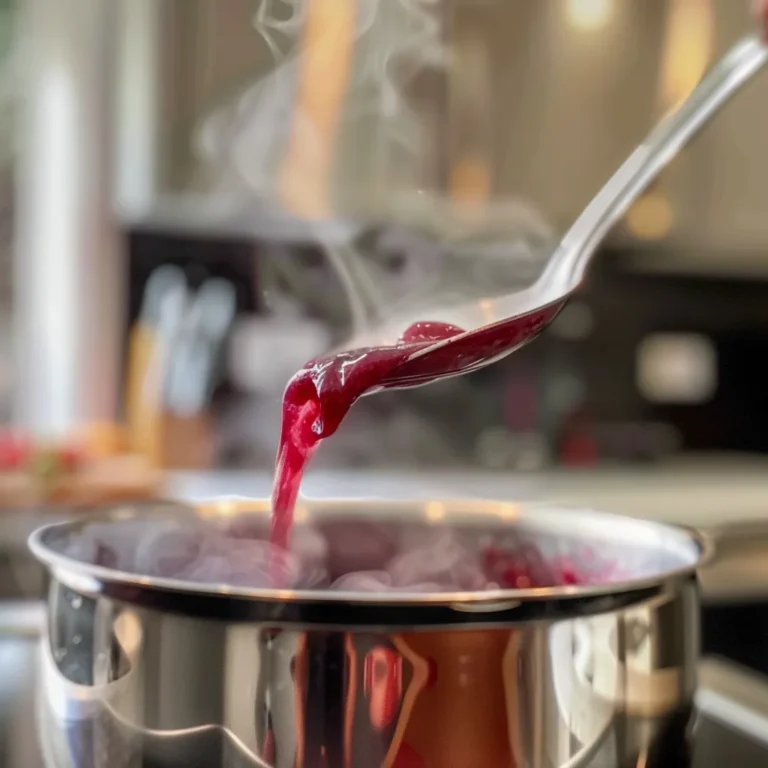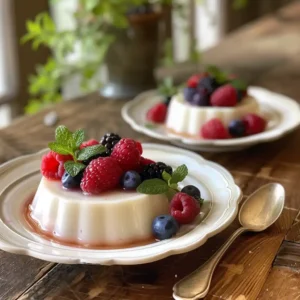Our Gelatine Trick Recipe isn’t just another kitchen fad—it’s a surprisingly simple way to add depth, texture, and even lightness to your everyday meals and desserts. From my own journey experimenting with food hacks in a small apartment kitchen, this trick opened up a whole new world. Whether it’s creating that perfect jelly without added sugar or using gelatin to give a silky body to savory sauces, this is one of those “why didn’t I do this sooner?” discoveries.
In this guide, I’ll walk you through exactly what this gelatine trick recipe is, how I use it in real life (and sometimes mess it up), and the kitchen lessons I’ve learned along the way. We’ll cover everything—from classic dessert transformations to savory kitchen shortcuts, plus a few healthy hacks I swear by.
It’s more than just “bloom and stir”—this is a true behind-the-scenes look at how gelatin works its magic when used intentionally. And guess what? You don’t need to be a pro chef to make this work. If you’re someone like me who just enjoys crafting better food at home, you’re in the right place.
Don’t miss our main guide to the gelatine trick recipe where I first shared my experience testing this method with berry-infused jellies and homemade marshmallows. Ready to dive in? Let’s start by demystifying what this “gelatine trick” actually is—and why it deserves a spot in your weekly kitchen routine.
Print
Gelatine Trick Recipe
Discover the surprisingly powerful gelatine trick recipe—a simple method to elevate both sweet and savory dishes with texture, structure, and clean flavor.
- Total Time: 15 minutes (plus chilling time)
- Yield: Varies by use
Ingredients
- 1 tablespoon powdered gelatin (or equivalent sheet gelatin)
- 1/4 cup cold water (for blooming)
- Additional water or liquid depending on your recipe
- Optional: natural fruit juice, broth, or milk for incorporation
Instructions
- In a small bowl, sprinkle gelatin over 1/4 cup cold water.
- Let it bloom for 5–10 minutes until fully absorbed.
- Gently heat the bloomed gelatin until fully dissolved—avoid boiling.
- Incorporate the dissolved gelatin into your desired recipe: fruit juice for jelly, cream for panna cotta, or broth for sauces.
- Pour the mixture into molds or containers.
- Chill in the refrigerator for at least 4 hours or until set.
Notes
Always bloom gelatin in cold water before heating. Avoid fresh pineapple, kiwi, or papaya unless cooked, as their enzymes break down gelatin. Adjust quantities depending on desired firmness.
- Prep Time: 10 minutes
- Cook Time: 5 minutes
- Category: Technique
- Method: No-Bake
- Cuisine: Universal
Nutrition
- Serving Size: 1 gelatin-enhanced dish
- Calories: 30
- Sugar: 0g
- Sodium: 15mg
- Fat: 0g
- Saturated Fat: 0g
- Unsaturated Fat: 0g
- Trans Fat: 0g
- Carbohydrates: 0g
- Fiber: 0g
- Protein: 7g
- Cholesterol: 0mg
What Is the Gelatine Trick Recipe?
When I first heard the term gelatine trick recipe, I imagined some overly complicated food hack only chefs in TV kitchens would know. But trust me—once you understand what it means, you’ll want to try it in your own meals immediately. The gelatine trick recipe is a simple but powerful technique that uses gelatin (yes, the same ingredient in jello) to change the texture, structure, or presentation of a dish—without altering its taste.
There are a few variations, but the basic gelatine trick recipe involves blooming powdered gelatin in cold water, then incorporating it into either a warm or cold recipe. Whether you’re creating a shiny fruit glaze, a dairy-free panna cotta, or a rich broth with body, this one ingredient makes a huge difference.
You’ve likely seen gelatin used in desserts, but the real beauty of the gelatine trick recipe is its versatility. It can firm up no-bake cheesecakes, give mousse that airy bounce, or make a homemade gummy snack feel professional. Some home cooks even stir gelatin into hot coffee for a protein kick—yeah, I tried that too.
There are different types of gelatin you can use in the gelatine trick recipe. I typically go for powdered gelatin because it’s easy to measure and works fast. Leaf or sheet gelatin is more traditional in European recipes and offers a clearer result. There are also plant-based alternatives like agar-agar, but they behave a bit differently in the gelatine trick recipe.
The first time I tried the gelatine trick recipe, I made a mistake: I didn’t bloom the powder long enough, and my jelly turned into a weird rubber disk. But that fail taught me an important lesson—blooming is not optional. It’s what activates the gelatin properly so it can dissolve smoothly.
If you’re curious about real-world uses, this gelatin weight-loss variation might surprise you with how people are using it in health trends. But don’t worry, we’ll stay rooted in taste and kitchen practicality here.
So whether you’re looking to firm up a dessert, thicken a sauce, or simply experiment with a new cooking technique, the gelatine trick recipe could be that game-changer you never knew you needed.
Why Use Gelatine in Recipes?
You might be wondering—why bother with the gelatine trick recipe when so many thickeners and stabilizers already exist? I asked myself the same thing years ago, back when I relied mostly on cornstarch and cream cheese to shape my desserts. But after giving the gelatine trick recipe a real chance, I understood why it’s such a quietly powerful tool in cooking.
The most obvious reason to use the gelatine trick recipe is for its texture-enhancing magic. Unlike flour or starch, gelatin doesn’t cloud liquids. That’s a huge deal when you’re making a clear jelly or a beautiful fruit glaze. I remember trying to replicate a tea jelly I had during a trip to Thailand—only the gelatine trick recipe gave me that perfectly smooth finish without messing with the flavor.
In savory dishes, this trick adds body to broths and sauces in a way that’s hard to match. Have you ever had that glossy, restaurant-style reduction that coats the spoon just right? That often comes from using a gelatine trick recipe, not just heavy cream. Even a spoonful added to soup or stew can subtly thicken it while keeping the flavor clean and bright.
Now, let’s talk about dessert. One of the best things I’ve made with a gelatine trick recipe was a dairy-free coconut panna cotta. It held its shape like a dream but still melted in the mouth. The key? Blooming just the right amount of gelatin and letting it set slowly—no shortcuts here. It’s not just about firmness; it’s about mouthfeel.
Another underrated benefit of the gelatine trick recipe is shelf life. It can help desserts hold up longer without weeping or separating. That’s a lifesaver when you’re prepping ahead for a gathering or just trying to make snacks that last a few days in the fridge.
Gelatin is also high in collagen, and while I won’t make health claims, let’s just say I don’t mind the possible skin and joint perks that come with this kitchen staple. In fact, this version focused on weight-loss benefits has become popular for exactly that reason—even though I’m mostly here for the texture.
Whether you’re new to it or already experimenting, the gelatine trick recipe brings a balance of function and finesse to your kitchen. Once you see how versatile it is, you’ll start slipping it into more dishes than you’d expect.
Classic Gelatine Trick Recipes You Should Know
When I first got into cooking, I stumbled upon the gelatine trick recipe while trying to make a fruit jelly that didn’t turn into a watery mess by day two. What started as a curious experiment quickly became one of my favorite kitchen moves. Let’s dive into some classic recipes where this trick truly shines.
One of the most iconic uses for the gelatine trick recipe is homemade fruit jelly. Not the boxed kind—but real, fresh juice set with gelatin. I tried making an orange basil jelly last summer using this method, and it came out smooth, shiny, and packed with flavor. The trick is in balancing the acidity of the fruit with the right amount of gelatin, and it’s easier than it sounds once you’ve done it once.
Another gem? The gelatine trick recipe for making a crystal-clear consommé or clarified broth. Now, I won’t pretend this is quick—it takes patience. But the result is a golden, jewel-like liquid that looks and tastes refined. You dissolve gelatin into a cooled broth, then let it trap the impurities as it firms up. Once strained, the broth becomes something that would feel right at home in a fine dining setting.
There’s also the old-school molded salad route—think vintage dinner parties with colorful layers of vegetables or fruits suspended in gelatin. I gave this a modern spin recently by combining cucumber, dill, and lemon into a savory appetizer jelly. Again, the gelatine trick recipe let me control firmness and set time, which made presentation a breeze.
Let’s not forget the kid-friendly options. Homemade gummy bears and gelatin squares are perfect for involving little ones in the kitchen. I’ve adjusted sugar content and used natural fruit purees, and the gelatine trick recipe always delivers a reliable texture that holds up—even in warm lunchboxes.
Each of these dishes shows off a different side of the gelatine trick recipe. Whether you’re after elegance, nostalgia, or just a functional way to prep ahead, these classics are where the magic starts.
Savory Gelatin Hacks for Everyday Cooking
You might associate gelatin with sweet treats, but let me tell you—some of the most surprising wins I’ve had using the gelatine trick recipe were in savory dishes. I didn’t realize how versatile gelatin could be until I tried it in a rich mushroom sauce. It thickened just enough to cling to the pasta without being heavy, and that’s the kind of balance the gelatine trick recipe is perfect for.
One of my favorite applications is adding body to bone broth. You can simmer bones for hours and still get a watery stock, but just a small amount of gelatin—prepared with the gelatine trick recipe—can add that luxurious mouthfeel. It’s especially helpful if you’re making a smaller batch and still want that nourishing texture. I’ve also found this helps soups feel more satisfying without extra fat.
Ever had a meatloaf that fell apart when sliced? I used to struggle with that too. Now, I mix in a little bloomed gelatin before shaping, and it holds together beautifully while staying moist. It’s a simple upgrade using the gelatine trick recipe that makes your comfort food look like it came out of a chef’s kitchen.
And here’s a tip I learned while prepping for a dinner party—if you want picture-perfect deviled eggs or salmon mousse that holds its shape on a serving tray, a touch of gelatin goes a long way. The gelatine trick recipe gives you control over firmness, which means no more weepy edges or sagging sides.
There’s a practical side, too. When I meal prep for the week, adding gelatin to certain sauces keeps them from separating after reheating. I’ve used this trick with a light gravy made from roasted vegetables and even a tamari-based stir-fry glaze. The gelatine trick recipe keeps everything cohesive, especially when stored in the fridge or freezer.
If you’re curious to try this out, check out my healthy takes like this high-protein soda twist where gelatin gives unexpected structure. Savory gelatin may not be mainstream, but once you try it, you’ll wonder how you ever cooked without it. Trust the gelatine trick recipe—it’s got more uses than most people realize.
Sweet Treats Made Better with Gelatine
If there’s one place the gelatine trick recipe truly shines, it’s in dessert-making. I used to think gelatin was only good for retro jello cups or boxed mixes, but once I began experimenting with more refined recipes, it became a kitchen essential. The results were smoother, silkier, and somehow more “grown-up”—all thanks to the gelatine trick recipe.
Take mousse, for example. Whether it’s chocolate, raspberry, or even matcha, the challenge is holding that airy texture without it collapsing. The gelatine trick recipe lets me create that perfect firmness without making the dessert feel heavy. I once made a lemon basil mousse for a friend’s birthday, and everyone assumed I’d bought it from a fancy patisserie.
Panna cotta is another dessert where the gelatine trick recipe performs like magic. The key is in how gently you bloom and dissolve the gelatin so it doesn’t clump or alter the delicate taste. The result? A silky, wobbling custard that looks impressive but takes less than 15 minutes to prepare. That’s my kind of win.
When I wanted to offer my nieces a treat without all the sugar, I used the gelatine trick recipe to make homemade fruit gummies. Just pureed berries, a bit of honey, and the right amount of gelatin. They were colorful, snackable, and surprisingly easy to store for the week. A few versions later, I started making layered jelly cups with coconut milk, mango, and chia—beautiful and totally beginner-friendly.
And if you’re watching calories, here’s the best part: the gelatine trick recipe allows you to make desserts without cream or starches. The result is a low-fat option that doesn’t compromise on texture. It’s a life-saver when I want something indulgent but light, especially after dinner.
Need inspiration? Don’t miss our fun hybrid dessert like this mochi-inspired creation where structure really matters. That’s another case where gelatin helped the filling set just enough to hold its shape without being dense.
Honestly, once you see how much better your desserts can be with the gelatine trick recipe, it becomes a habit. It’s not just about setting—it’s about elevating everything from flavor to presentation.
Healthy Uses of Gelatin in My Kitchen
When I first started exploring the gelatine trick recipe, it wasn’t for dessert. It was actually during my wellness phase—one of those post-vacation resets—where I wanted something light, gut-friendly, and nourishing. That’s when I stumbled into using gelatin for more than just setting jello. What began as a small experiment quickly became a daily habit.
Every morning, I prepare a warm lemon water drink, and now I stir in a teaspoon of bloomed gelatin. This gelatine trick recipe gives the drink a slightly richer mouthfeel and helps me feel fuller for longer. Some say it may support digestion or promote skin health, and while I can’t promise results, I personally enjoy the subtle boost it gives me.
One of my go-to snacks lately has been protein-packed energy bites. I blend oats, nut butter, a touch of honey, and a small amount of gelatin dissolved using the gelatine trick recipe. These bites hold together better, store beautifully in the fridge, and offer a chewy texture that reminds me of soft granola bars.
I’ve even added the gelatine trick recipe to smoothies during warmer months. When blended and chilled, it gives my drinks a lightly set, almost pudding-like texture. Not only does this make it more satisfying, but it also keeps the smoothie from separating if I store it for later.
Another surprising discovery? Using gelatin to cut cravings. When I make a batch of low-sugar fruit jelly cups with the gelatine trick recipe, I’m less likely to reach for processed snacks. It feels like dessert, but it’s light, clean, and completely customizable with seasonal fruits.
And for those tracking protein or collagen intake, adding gelatin is an easy win. The gelatine trick recipe lets you do that naturally without pills or powders. I always recommend starting small—just a teaspoon bloomed properly—and gradually exploring where it fits best in your routine.
If you want more creative wellness recipes, this collagen smoothie idea might spark some ideas. It’s proof that gelatin isn’t just for grandma’s jello mold—it’s a modern tool for the mindful home cook.

Kitchen Fails to Avoid with Gelatine
I’ll be honest—the first few times I tried the gelatine trick recipe, things didn’t go so smoothly. There was the time I tried to speed up the setting process by skipping the blooming step. Big mistake. I ended up with lumpy bits floating in my panna cotta. Not exactly the creamy dream I had in mind.
The gelatine trick recipe is simple, but it’s not forgiving if you don’t respect the process. Blooming gelatin means letting it sit in cold water for a few minutes before heating. This hydrates the granules so they dissolve evenly. If you toss dry gelatin straight into hot liquid, it clumps—and no amount of stirring will fix it.
Temperature matters, too. One night, I tried the gelatine trick recipe for a spiced apple jelly and poured the hot mix into plastic cups that weren’t heat-safe. They melted, the jelly leaked, and I had a sticky disaster on my counter. Lesson learned: always check your containers and let the mix cool slightly before pouring.
There’s also the setting time. I’ve ruined more than one dessert by being impatient. The gelatine trick recipe needs time—typically 4 to 6 hours in the fridge—to fully firm up. Cutting corners here means a soft, weeping mess instead of that clean slice you were hoping for.
One tip that saved me? Always test your ratio with small batches. The strength of gelatin varies between brands, and when you’re following the gelatine trick recipe, even a half-teaspoon off can change the whole outcome. I keep a sticky note inside my spice drawer with my ideal ratios—it’s been a game changer.
And don’t forget that gelatin doesn’t play well with pineapple, kiwi, or papaya unless those fruits are cooked first. I learned that the hard way when my tropical jelly stayed liquid for days. Enzymes in those fruits break down the protein, so the gelatine trick recipe simply won’t work unless you prep properly.
The point is, these little mistakes helped me understand how powerful—and particular—the gelatine trick recipe can be. Now, those missteps have turned into lessons I rely on every time I bring out the gelatin packet.
Cultural and Travel Moments That Inspired Me
Travel has a way of sneaking into your kitchen when you least expect it. For me, the gelatine trick recipe became more than just a cooking technique—it turned into a souvenir of sorts, collected through flavors and memories from around the world.
During a trip to Morocco, I was offered a rosewater-infused milk jelly as part of a wedding celebration. It was delicate, floral, and unlike anything I’d had before. I later learned that a version of the gelatine trick recipe was used to set it just enough for a spoon to slide through cleanly. That dessert stuck with me. When I got home, I recreated it using my own blend of almond milk, rose syrup, and gelatin. That recipe now lives in my handwritten kitchen notebook, next to a note that simply says: “Marrakech magic.”
In Thailand, I had a street food dessert made of layered pandan and coconut jelly, sold in tiny plastic cups from a cart near the river. It had a bounce to it—smooth, not rubbery—and I was fascinated. The vendor didn’t speak much English, but he pointed to a packet of gelatin and grinned. That was my first introduction to the cultural reach of the gelatine trick recipe. Back home, I attempted my own version with steeped pandan leaves and found a whole new respect for the precision required.
Even closer to home, while visiting family in the South, I watched an aunt prepare ambrosia with a jello base. She didn’t call it the gelatine trick recipe, but that’s exactly what it was. She bloomed her gelatin, folded in citrus, marshmallows, and sour cream, and let it chill overnight. That dessert wasn’t just about nostalgia—it was a practical, affordable way to feed a crowd with style.
Each of these experiences taught me that the gelatine trick recipe isn’t bound to any one cuisine or trend. It’s been reimagined across cultures, always delivering comfort, elegance, or innovation depending on the setting. That’s what makes it so special—it travels well and adapts easily, much like a good recipe should.
Frequently Asked Questions About the Gelatine Trick Recipe
What’s the best way to use gelatin in cold recipes?
If you’re using the gelatine trick recipe for a chilled dessert or drink, always bloom your gelatin first in cold water, then gently melt it before adding to your mix. I usually let the bloomed gelatin sit for five minutes, then heat it just enough to dissolve—never boil it. That small step ensures the final dish sets perfectly without gritty bits or clumps.
Final Thoughts on the Gelatine Trick Recipe
After years of testing, tweaking, and occasionally messing up, I can confidently say the gelatine trick recipe has earned a permanent spot in my kitchen toolkit. It’s one of those rare techniques that works across every type of dish—savory, sweet, simple, or fancy—and still manages to surprise me every time I use it.
Whether you’re trying to impress guests with a silky panna cotta or just want your homemade broth to have that restaurant-quality body, the gelatine trick recipe delivers. It’s not flashy, but it’s reliable. And in home cooking, that matters. I’ve used it to fix sauces, save broken desserts, and elevate simple snacks like fruit cups into something worth serving with pride.
Of course, mastering it takes patience. The bloom time, the ratios, the cooling process—all of it matters. But once you’ve got the rhythm down, the gelatine trick recipe becomes second nature. I find myself reaching for that little container of powdered gelatin more often than I expected, especially when I want to keep recipes light without sacrificing texture.
One thing I love most about this trick is how versatile it is. You can use it for indulgent desserts, wellness-focused snacks, or weeknight dinners with the same dependable result. That’s rare. For more recipe inspiration, don’t miss this simple gelatin-based idea that started my journey in the first place.
So if you haven’t yet tried the gelatine trick recipe, now’s the time. Start small, stay curious, and let your creativity do the rest. It’s one of the easiest ways I’ve found to turn everyday ingredients into something unexpectedly special.
And hey—if you’re looking for more tips and fresh recipes, feel free to follow me on Pinterest or check out my daily kitchen experiments on Facebook. There’s always something new cooking!







